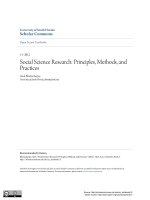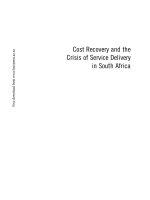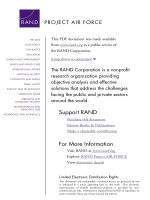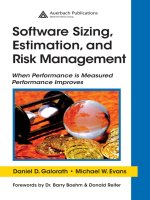Software Cost Estimation and Sizing Methods - Issues and Guidelines pptx
Bạn đang xem bản rút gọn của tài liệu. Xem và tải ngay bản đầy đủ của tài liệu tại đây (342.57 KB, 127 trang )
Visit RAND at www.rand.org
Explore RAND Project AIR FORCE
View document details
For More Information
This PDF document was made available
from www.rand.org as a public service of
the RAND Corporation.
6
Jump down to document
This document and trademark(s) contained herein are protected by law
as indicated in a notice appearing later in this work. This electronic
representation of RAND intellectual property is provided for non-
commercial use only. Permission is required from RAND to reproduce, or
reuse in another form, any of our research documents.
Limited Electronic Distribution Rights
THE ARTS
CHILD POLICY
CIVIL JUSTICE
EDUCATION
ENERGY AND ENVIRONMENT
HEALTH AND HEALTH CARE
INTERNATIONAL AFFAIRS
NATIONAL SECURITY
POPULATION AND AGING
PUBLIC SAFETY
SCIENCE AND TECHNOLOGY
SUBSTANCE ABUSE
TERRORISM AND
HOMELAND SECURITY
TRANSPORTATION AND
INFRASTRUCTURE
WORKFORCE AND WORKPLACE
The RAND Corporation is a nonprofit
research organization providing
objective analysis and effective
solutions that address the challenges
facing the public and private sectors
around the world.
Purchase this document
Browse Books & Publications
Make a charitable contribution
Support RAND
This product is part of the RAND Corporation monograph series.
RAND monographs present major research findings that address the
challenges facing the public and private sectors. All RAND mono-
graphs undergo rigorous peer review to ensure high standards for
research quality and objectivity.
4IBSJ-BXSFODF1GMFFHFS'FMJDJB8V3PTBMJOE-FXJT
1SFQBSFEGPSUIF6OJUFE4UBUFT"JS'PSDF
"QQSPWFEGPSQVCMJDSFMFBTFEJTUSJCVUJPOVOMJNJUFE
4PGUXBSF
$PTU&TUJNBUJPO
BOE4J[JOH.FUIPET
*TTVFTBOE(VJEFMJOFT
4HE2!.$#ORPORATIONISANONPROFITRESEARCHORGANIZATIONPROVIDING
OBJECTIVEANALYSIS AND EFFECTIVE SOLUTIONS THATADDRESS THE CHALLENGES
FACING THEPUBLIC AND PRIVATE SECTORS AROUND THE WORLD 2!.$S
PUBLICATIONSDONOTNECESSARILYREFLECTTHEOPINIONSOFITSRESEARCHCLIENTS
ANDSPONSORS
®
ISAREGISTEREDTRADEMARK
Ú#OPYRIGHT2!.$#ORPORATION
!LL RIGHTS RESERVED .OPART OF THISBOOK MAY BE REPRODUCEDIN ANY
FORM BY ANY ELECTRONIC ORMECHANICAL MEANS INCLUDING PHOTOCOPYING
RECORDINGORINFORMATION STORAGE AND RETRIEVAL WITHOUT PERMISSION IN
WRITINGFROM2!.$
0UBLISHEDBYTHE2!.$#ORPORATION
-AIN3TREET0/"OX3ANTA-ONICA#!
3OUTH(AYES3TREET!RLINGTON6!
.ORTH#RAIG3TREET3UITE0ITTSBURGH0!
2!.$52,HTTPWWWRANDORG
4OORDER2!.$DOCUMENTSORTOOBTAINADDITIONALINFORMATIONCONTACT
$ISTRIBUTION3ERVICES4ELEPHONE
&AX%MAILORDER RANDORG
,IBRARYOF#ONGRESS#ATALOGINGIN0UBLICATION$ATA
0FLEEGER3HARI,AWRENCE
3OFTWARECOSTESTIMATIONANDSIZINGMETHODSISSUESANDGUIDELINES
3HARI,AWRENCE0FLEEGER&ELICIA7U2OSALIND,EWIS
PCM
h-'v
)NCLUDESBIBLIOGRAPHICALREFERENCES
)3".PBKALKPAPER
#OMPUTERSOFTWARE$EVELOPMENT-ANAGEMENT)7U&ELICIA))
,EWIS2OSALIND)))4ITLE
1!0
DC
4HERESEARCHDESCRIBEDINTHISREPORTWASSPONSOREDBYTHE5NITED3TATES
!IR&ORCEUNDER#ONTRACT&#&URTHERINFORMATIONMAY
BEOBTAINEDFROMTHE3TRATEGIC0LANNING$IVISION$IRECTORATEOF0LANS
(Q53!&
iii
Preface
Software has played an increasingly important role in systems acquisi-
tion, engineering, and development, particularly for large, complex
systems. For such systems, accurate estimates of the software costs are
a critical part of effective program management. The practice of pre-
dicting the cost of software has evolved, but it is far from perfect.
Military and commercial programs alike are replete with examples of
software cost estimates that differ significantly from the actual costs at
completion.
Rather than seeking the perfect cost-estimation method, this re-
port recommends an approach to improving the utility of the soft-
ware cost estimates by exposing uncertainty (in understanding of the
project as well as in costing accuracy) and reducing the risk that the
estimate will be far different from the actual cost. The two primary
factors addressed in this report are the decisions made during the es-
timation process (such as which methods and models are most ap-
propriate for a given situation) and the nature of the data (such as
software size) used in the estimation process. This report acknowl-
edges the presence and effect of risk in any software estimate and of-
fers pragmatic strategies for risk mitigation.
The techniques described here are based on literature reviews
and analysis of software estimation and risk, in addition to general
lessons and guidance adapted from selected programs described by
cost analysts interviewed at the Air Force Cost Analysis Agency
(AFCAA). This study was sponsored by the Assistant Secretary of the
Air Force (Acquisition), in conjunction with AFCAA. The AFCAA
iv Software Cost Estimation and Sizing Methods: Issues and Guidelines
supports the Air Force Secretariat by conducting independent cost
analyses, special cost reviews, and cost-analysis research for Air Force
component organizations.
This report is intended to assist experienced cost analysts in re-
ducing the risk of inaccurate cost estimates. It should be of particular
interest to those organizations or agencies that use software estimates
in the planning, budgeting, developing, and/or purchasing of
software-intensive systems. Additionally, this report should be of
value to those involved in research and analysis of estimation models
and techniques.
The research was sponsored by the Principal Deputy, Office of
the Assistant Secretary of the Air Force (Acquisition) Lt Gen John
D.W. Corley. The project technical monitor was Jay Jordan, the
Technical Director of the Air Force Cost Analysis Agency.
This report should be of interest to government cost analysts,
the military aircraft and missile acquisition communities, and those
concerned with current and future acquisition policies.
Other RAND Project AIR FORCE reports that address military
aircraft cost-estimating issues include the following:
• In An Overview of Acquisition Reform Cost Savings Estimates,
MR-1329-AF, Mark Lorell and John C. Graser used relevant
literature and interviews to determine whether estimates of the
efficacy of acquisition-reform measures are robust enough to be
of predictive value.
• In Military Airframe Acquisition Costs: The Effects of Lean
Manufacturing, MR-1325-AF, Cynthia Cook and John C.
Graser examine the package of new tools and techniques known
as “lean production” to determine whether it would enable air-
craft manufacturers to produce new weapon systems at costs
below those predicted by historical cost-estimating models.
• In Military Airframe Costs: The Effects of Advanced Materials and
Manufacturing Processes, MR-1370-AF, Obaid Younossi,
Michael Kennedy, and John C. Graser examine cost-estimating
methodologies and focus on military airframe materials and
manufacturing processes. This report provides cost analysts with
Preface v
factors useful in adjusting and creating estimates based on para-
metric cost-estimating methods.
• In Military Jet Engine Acquisition: Technology Basics and Cost-
Estimating Methodology, MR-1596-AF, Obaid Younossi, Mark
V. Arena, Richard M. Moore, Mark Lorell, Joanna Mason, and
John C. Graser present a new methodology for estimating
military jet engine costs and discuss the technical parameters
that derive the engine development schedule, development cost,
and production costs, and present quantitative analysis of
historical data on engine-development schedules and costs.
• In Test and Evaluation Trends and Costs for Aircraft and Guided
Weapons, MG-109-AF, Bernard Fox, Michael Boito, John C.
Graser, and Obaid Younossi examine the effects of changes in
the test and evaluation (T&E) process used to evaluate military
aircraft and air-launched guided weapons during their
development programs.
RAND Project AIR FORCE
RAND Project AIR FORCE (PAF), a division of the RAND
Corporation, is the U.S. Air Force’s federally funded research and de-
velopment center for studies and analyses. PAF provides the Air Force
with independent analyses of policy alternatives affecting the devel-
opment, employment, combat readiness, and support of current and
future aerospace forces. Research is performed in four programs:
Aerospace Force Development; Manpower, Personnel, and Training;
Resource Management; and Strategy and Doctrine. The research re-
ported here was conducted within the RAND Project AIR FORCE
Resource Management Program.
Additional information about PAF is available on our web site at
/>
vii
Contents
Preface iii
Figures
xi
Tables
xiii
Executive Summary
xv
CHAPTER ONE
Introduction 1
Study Methodology
4
1. Risk and Software Cost Estimation
4
2. Sources of Risk in Software Estimates
4
3. Options in Developing Estimates
5
4. Strategies for Risk Mitigation
5
Report Organization
5
CHAPTER TWO
Balancing the Advantages and Disadvantages of Sizing Methods 9
Characterizing Sizing Methods
12
When to Use a Sizing Method
13
Issue: Counting Physical Objects
14
Issue: Counting Notional Constructs
16
Issue: Lack of Empirical Evidence, Especially for New
Sizing Methods
17
Issue: Using Past Project Experience and Information
18
Issue: Tracking Changes and Progress over Time
19
Issue: Calibration
21
viii Software Cost Estimation and Sizing Methods: Issues and Guidelines
CHAPTER THREE
Survey of Sizing Methods 23
Lines of Code
24
Function Points and Feature Points
27
Object Points
31
Application Points
33
Predictive Object Points
34
Analogies
37
Estimating from Unified Modeling Language Constructs
39
CHAPTER FOUR
Risk Checklist for Sizing Methods 43
Risks
44
The Specification or Design
46
The Development Method
48
The Estimation Process
49
CHAPTER FIVE
Checklist for Reviewing Size-Estimation Risk 55
1. Sizing-Method Selection
55
2. Project/System Assessment
56
3. Sizing-Method Application
57
CHAPTER SIX
Approaches to Cost Estimation 61
Using Cost Estimates
62
Buyers
63
Developers
63
Users
64
Researchers
64
Cost-Estimation Approaches
64
1. Expert Judgment Method
65
2. Analogy Method
67
3. Parametric/Algorithmic Method
68
4. Bottom-Up/Work Breakdown Structure Method
74
5. Top-Down Method
75
Contents ix
Historical Databases to Support Estimation 76
CHAPTER SEVEN
Risks in Cost Estimation 77
Sources of Risk and Error
78
1. System Definition
79
2. System Development
81
3. Estimation Process
83
CHAPTER EIGHT
Final Directions 91
References
93
xi
Figures
3.1. Transforming Characteristics into Lines of Code 25
3.2. Transforming Requirements into Function or
Feature Points
28
3.3. Transforming Characteristics into Object Points
31
3.4. Using Analogies to Generate a Size Estimate
38
3.5. Generating a Size Estimate from Use Cases
40
4.1. Relationships Among Uncertainties and Errors
44
6.1. (a) The Ideal Case, in Which Estimated Values Are Equal
to Actual Values; and (b) the Typical Case, in Which
Estimated Values Differ from Actual Values
68
7.1. How Uncertainties in Critical Components of a Software
Project Lead to Risks That May Affect Cost- or Schedule-
Estimation Accuracy
78
xiii
Tables
3.1. Initial Function-Point Count 28
3.2. Object-Point Calculation
33
3.3. Application Points
34
xv
Executive Summary
Introduction (see pp. 1–7)
Estimating the size and cost of software is a risky business. When
software is a crucial component in numerous space, weapon, aircraft,
and information technology projects critical to operations, as it often
is for the Air Force, accurate estimates of software costs are essential.
Because software size is usually the most influential factor in deter-
mining software costs, good estimates of size are critical to good cost
estimation. Rather than seeking the perfect method for estimating
size and cost exactly, a more realistic approach to improving estima-
tion is to reduce the risks (that is, to anticipate likely problems) asso-
ciated with improper sizing and costing of software.
Consequently, the goal of this report is to aid experienced cost
analysts in understanding the sources of uncertainty and risk in sizing
and costing software, and to provide insight into mitigating the risks
when making choices about different sizing and costing options. We
pay particular attention to the early stages of a project, when many of
the factors needed to support estimation (such as the particulars of
each system requirement) may be unknown or uncertain.
The notion of risk is central to any such analysis, and two tech-
niques can improve accountability of risks relating to software esti-
mates: identifying areas of uncertainty (that may lead to risky
situations) and analyzing the estimation process to determine where
xvi Software Cost Estimation and Sizing Methods: Issues and Guidelines
risk mitigation can reduce the uncertainty. The first technique
increases an analyst’s diligence in reporting uncertainty. The second
technique involves actually addressing and mitigating risks in the
estimation process, thereby reducing the total uncertainty and
increasing the estimate’s accuracy. The two techniques are com-
plementary. The first improves accountability by reporting the
uncertainty. The second improves accountability by dealing with and
reducing the uncertainty.
This document addresses both techniques, offering guidelines to
cost analysts on how best to manage the unavoidable risks that are
attendant on predicting software size and cost. These techniques in-
ject realism into the estimation process, acknowledging that estimates
are often made with limited knowledge of the system and a profusion
of choices that may be rife with uncertainty.
Sizing Methods (see pp. 9–13)
Software size estimation is critical to providing a credible software
cost estimate; thus, choosing the appropriate method by which to es-
timate size is important. In most cases, the estimation risk (that is, the
possibility that the estimate will be far different from the actual
software cost) depends more on accurate size estimates than on any
other cost-related parameter. Thus, it is important that software
sizing be done as consistently and accurately as possible, given the
uncertainties inherent in estimation.
However, software sizing is difficult for a number of reasons.
First, it is performed in a variety of different contexts,
1
some with a
great deal of knowledge about the system and some with almost no
knowledge at all. Second, there are many choices for the language and
structure used to express the requirements and design. Third, soft-
ware projects are often a combination of new, reused, and modified
____________
1
The context depends on the resources available to the project, the degree to which the
developers are familiar with the problem to be solved by the software, the developers’
expertise in the problem domain and with the development tools, and more.
Executive Summary xvii
components. A sizing method must be able to incorporate all three
modes, even when the reuse and modification occur in the require-
ments and design instead of just in the code.
Both sizing and costing methods typically belong to one of two
types, or a combination of the two types: expert judgment or measur-
able items. The expert judgment method relies on the ability of one
or more analysts to determine the likely product size by evaluating
the nature of the requirements, often in some qualitative fashion.
Usually, the analysts have knowledge of similar development efforts,
and the degree of similarity is relative to their understanding of the
proposed project. By contrast, sizing based on quantitative,
measurable items can use aspects of the requirements, such as number
of requirements, number of transactions and screens, or other
constructs (such as function points), to suggest the resulting size.
With this approach, the size-estimation process is often more formal;
the analysts are guided by questions or steps to elicit parameters from
which the likely size is then calculated.
Advantages and Disadvantages of Sizing Methods
Several global issues should be considered when using a sizing
method. We discuss them in the following categories (see pp. 13–22):
• Counting physical objects, such as lines of code or number of
requirements. Advantages include ease of counting (and ease of
counting automation), independence of programming language,
ease of storage in a historical database, and ease of management
understanding. Disadvantages include difficulty of counting
early in the development process, dependence on programming
or specification style, need for rigor in applying counting rules,
and inconsistency of methods across different languages.
• Counting notional constructs, such as function points or appli-
cation points. These objects may be easier than physical objects
to define early in the development process, but as notional ideas
they are often more difficult to track over the course of devel-
xviii Software Cost Estimation and Sizing Methods: Issues and Guidelines
opment. Advantages include ease of generation from a clear
specification and persistence across intermediate products (such
as design or early code modules). Disadvantages include incon-
sistency as analysts interpret the notional constructs (leading to
the need for careful and consistent analyst training) and the dif-
ficulty of assessing the size of embedded systems.
• Lack of empirical evidence, especially for new sizing methods. A
new sizing method may be more appropriate for a new devel-
opment technique than are existing methods, but there may not
yet be empirical evidence available to suggest appropriate values
for input variables.
• Using past project experience and information. Many estimation
techniques rely to some degree on the availability of information
about past projects. This reliance can leverage lessons learned on
earlier projects and reduce variability in input values. However,
seeming similarities may mask significant differences in the new
project. In addition, historical information may not be in a for-
mat useful for a new sizing method.
• Tracking changes and progress over time. Using size to track
progress may help to manage the expectations of developers and
customers alike. But many sizing models are designed to be used
at the beginning of development, not in the middle; a size esti-
mate built from the factors related to one goal may be inappro-
priate when the goal changes. Moreover, different size measures
generated over the course of development may not be compara-
ble over time.
• Calibrating the model. Calibration tailors the model to an orga-
nization or development style. When the calibration is per-
formed carefully, the resulting tailored models tend to be more
accurate than all-purpose ones. However, new or radically dif-
ferent projects may not be estimated accurately from the cali-
brated model.
After discussing the ramifications of each issue, we describe
seven different sizing methods that the analyst may use (see pp.
23–41). For each method, we present its sources or origins in
Executive Summary xix
software literature, useful references to related web sites and articles,
and a description of how each method works, when to use it, and
when not to use it. Included are the following:
• Source lines of code (SLOC): a method that estimates the total
number of lines of code in the finished software project
• Function points and feature points: methods that measure the
amount of functionality in a system by counting and weighting
inputs, outputs, queries, and logical and interface files
• Object points: a method that measures size by high-effort items,
such as server data tables, client data tables, and screens and re-
ports reused from previous projects
• Application points: a method building on object points, adding
rating scales of a project’s productivity
• Predictive object points: a method also building on object
points, adding information about how objects are grouped into
classes
• Analogies: a method using other, completed projects with simi-
lar characteristics to the proposed project to suggest the likely
size
• Unified Modeling Language (UML) constructs: a relatively new
method based on use case, a technique for describing how users
will interact with the system to perform functions.
For example, Boehm et al. (2000) revised the object-point ap-
proach for use in the COCOMO II estimation process. Calling their
technique “application points” to avoid confusion with object points
and object-oriented development, they added rating scales to deter-
mine a project’s productivity in new object points per person-month,
the development environment’s maturity and capability, and the de-
veloper’s experience and capability in using the development (inte-
grated, computer-assisted software engineering, or ICASE) environ-
ment. That is, application points are an enhancement of object
points, designed to include more information about the project and,
thus, to reduce uncertainty. A table assists analysts in choosing a rat-
ing (from very low to very high) for each of the three additional
xx Software Cost Estimation and Sizing Methods: Issues and Guidelines
scales; the ratings are combined with other ratings. Then the resulting
application points measure acts as a size input to an effort estimate.
The estimated number of person-months is calculated as the number
of application points divided by the productivity measure in the table.
Application points are to be used specifically with COCOMO II
effort- and schedule-estimation models. There is no evidence that
application points are useful in models other than COCOMO II.
However, as other estimating techniques embrace the changes in
COCOMO II, new evidence may support a decision to switch to ap-
plication points for sizing.
Of course, all sizing methods have their advantages and dis-
advantages, depending on the level of knowledge about the system;
variation in the languages and structures used to implement the
system; and system composition (the use of new, reused, and modi-
fied code within a system). Selecting the appropriate size-estimation
method helps mitigate the risks associated with each choice.
Risks in Size Estimation
Risk occurs at many points in a project’s life cycle and is tied to
activities or to timing. When a decision or choice is made (whether
on the micro-level, such as how to design a particular software mod-
ule or on the macro-level, such as which software architecture to
employ), an element of uncertainty is introduced in the estimation
process; this choice increases the risk and, thus, the chance for error.
This uncertainty is further aggravated when cost estimates must be
made very early in the project’s life cycle. (See pp. 43–53.)
Thus, it is important to recognize the risks and deal with them
properly. One source of estimation error is the presence of incorrect
or incomplete data elements, such as descriptions of how the software
will be developed or notions of how the user will use the software
system. Another source of error derives from correct data being used
incorrectly, as when a computation is not complete or is applied in-
appropriately. But these errors themselves are derived from three
Executive Summary xxi
kinds of uncertainty: (1) in the specification or design, (2) about the
development method, and (3) in the estimation process.
We consider the following risks important to each of the above
categories:
• Uncertainty in the specification or design
– Problems in understanding the requirements or design
– Incomplete or inconsistent requirements or design
• Uncertainty about the development method
– Economies and diseconomies of scale
– Mismatch between the proposed development method and
the estimation’s assumed method
• Uncertainty in the estimation process
– Subjectivity and lack of independence in the adjustment
factors
– Counter-intuitive values for adjustment factors
– Adjustment factors that seem irrelevant to the current project
– Rater bias
– Inter-rater disagreements
– Inappropriate use of measurement.
Each of these risks is described in terms of symptoms and
warning signs; these, in turn, can alert the analyst to the possibility of
risk, and we recommend mitigation strategies for each. For example,
consider the risk of diseconomies of scale. Sometimes, techniques that
have good effects in the small can have bad effects in the large. For
instance, using formal methods to prove the correctness of require-
ments has been shown to find problems in requirements, but using
formal methods on a large scale can be expensive, time-consuming,
and sometimes infeasible. Symptoms of diseconomies of scale include
inability to judge the effects of the candidate technology on the size
of development and inability to decide which parts of the system
should be subjected to the technology (such as deciding which por-
tions of the requirements should be proven correct using formal
methods). To mitigate this risk, it may be useful to decompose the
system into subsystems and then do a size estimate for each sub-
xxii Software Cost Estimation and Sizing Methods: Issues and Guidelines
system. Such decomposition can be based on the work breakdown
structure (WBS, a formal description of the tasks and their
dependencies) or on functional subsystems, each of which will be de-
veloped in a different way.
In addition to describing each risk, we provide a risk checklist
for size estimation to which an analyst may refer repeatedly through-
out the project’s life cycle. This checklist refers to three important
stages in the project life cycle: selection of the sizing method, assess-
ment of the project/system, and application of the cost-estimation
method. In each of these stages, we suggest actions that may help the
analyst to avoid risks in the short term and long term. (See pp.
55–59.)
Approaches to Cost Estimation (see pp. 61–76)
Sizing is only one aspect of estimating how much effort will be in-
volved in developing, delivering, and maintaining software. We ana-
lyze the broader issues of cost estimation, acknowledging that cost
estimation is as much an art as a science.
Cost estimates for software development and maintenance ac-
tivities are frequently associated with decisions about affordability,
investment, and value. Affordability includes not only the costs nec-
essary to accomplish the development but also those costs that
address training, repair, and upgrades over the intended system’s life
cycle. Investment decisions consider whether the associated costs will
yield a specific capability within the time and resources available.
Value may consider whether other options can provide a more
affordable or less risky investment to achieve the desired capability.
Thus, the way in which a cost estimate is used often depends on
the types of decisions that need to be made, when they are needed,
and who is making them. In particular, we can view a cost estimate
from the perspective of the system’s buyer, developer, or user, as well
as from the perspective of a researcher who is trying to analyze how
well a model or technique meets intended needs. The different uses of
cost estimates suggest that the inherent risks differ, based on perspec-
Executive Summary xxiii
tive and need. Thus, the relationship of risk to cost estimation can be
understood only with a concomitant understanding of how the esti-
mation is performed.
To that end, we review several widely recognized methods for
estimating software cost, from informal methods that rely heavily on
experience and expertise, to very formal parametric methods based on
formulas derived from past performance. The methods include expert
judgment, analogy, parametric and algorithmic methods, bottom-up
(work breakdown structure) methods, and top-down methods. For
each method, we describe how it works, the advantages and dis-
advantages, and appropriate usage.
For example, methods using analogy rely on data from actual
projects, thereby avoiding expert judgment’s reliance on recall. They
also avoid the complexity of parametric/algorithmic models. Tem-
plates can be built to characterize different kinds of projects or project
attributes, to explicitly account for differences between previous
projects and the proposed project. Tools, such as Bournemouth
University’s ANGEL (Shepperd and Schofield, 1997), can be used to
support the estimation.
However, there are several disadvantages to using analogies.
Because this method depends on expert judgment to account for dif-
ferences and to extrapolate from a previous project to the current
project, it can be challenging and subjective. Two projects that may
seem similar may indeed be different in a critical way (just as a runner
who runs a four-minute mile cannot run a marathon in under two
hours). Moreover, the uncertainty in assessing similarity and differ-
ence means that two different analysts may have significantly differ-
ent views and eventual estimates. This difficulty can be mitigated by
using historical data, which in turn requires maintaining and using a
database of templates or project data.
As with expert judgment, analogy is not suitable when the esti-
mation analysts have neither experience nor data for similar projects.
Similarly, the method is not useful when some aspect of the proposed
system is dramatically different in some way from most of the other
projects in the database or in the analysts’ experience. However,
analogies may be useful when estimates are needed from sparse, high-









